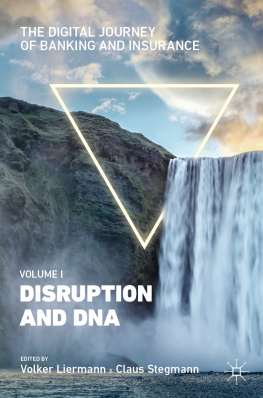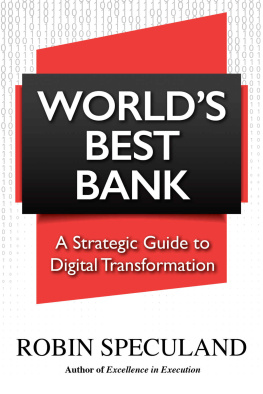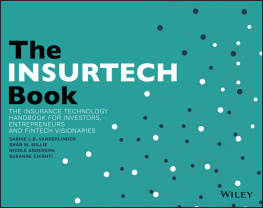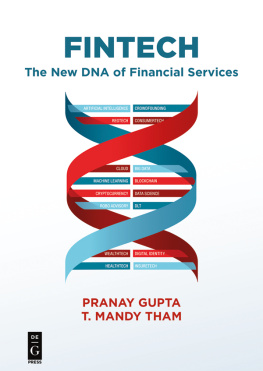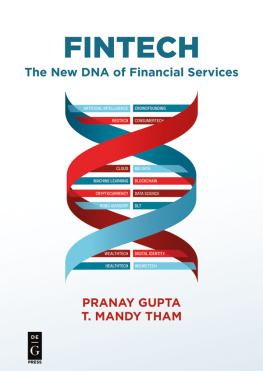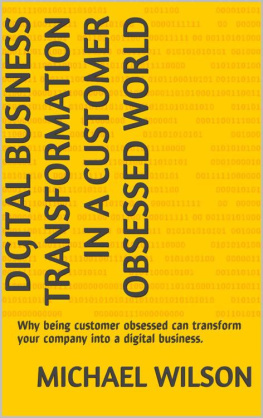Editors
Volker Liermann and Claus Stegmann
The Digital Journey of Banking and Insurance, Volume I
Disruption and DNA
1st ed. 2021

Logo of the publisher
Editors
Volker Liermann
ifb SE, Grnwald, Germany
Claus Stegmann
ifb Americas, Inc., Charlotte, NC, USA
ISBN 978-3-030-78813-1 e-ISBN 978-3-030-78814-8
https://doi.org/10.1007/978-3-030-78814-8
The Editor(s) (if applicable) and The Author(s), under exclusive license to Springer Nature Switzerland AG 2021
This work is subject to copyright. All rights are solely and exclusively licensed by the Publisher, whether the whole or part of the material is concerned, specifically the rights of translation, reprinting, reuse of illustrations, recitation, broadcasting, reproduction on microfilms or in any other physical way, and transmission or information storage and retrieval, electronic adaptation, computer software, or by similar or dissimilar methodology now known or hereafter developed.
The use of general descriptive names, registered names, trademarks, service marks, etc. in this publication does not imply, even in the absence of a specific statement, that such names are exempt from the relevant protective laws and regulations and therefore free for general use.
The publisher, the authors and the editors are safe to assume that the advice and information in this book are believed to be true and accurate at the date of publication. Neither the publisher nor the authors or the editors give a warranty, expressed or implied, with respect to the material contained herein or for any errors or omissions that may have been made. The publisher remains neutral with regard to jurisdictional claims in published maps and institutional affiliations.
Cover credit: Stutterstock/Yevhenii Chulovskyi
This Palgrave Macmillan imprint is published by the registered company Springer Nature Switzerland AG
The registered company address is: Gewerbestrasse 11, 6330 Cham, Switzerland
Not everything is changing, but most of the things changing can be of a disruptive characterso Im happy that Disruption and DNA is picking up exactly this intention.
Gerhard Lahner, COO of Vienna Insurance Group
In Disruption and DNA, finally someone is saying out loud that not everything is changing, but most of the things changing can be of a disruptive character.
Dr. Carsten Stolz, CFO Baloise Group
This first volume Disruption and DNA of the book series The Digital Journey of Banking and Insurance offers an extensive market view of digital transformation, including special insights into accounting and risk management. The book explores the often underestimated topics culture and project management.
Bernhard Hodler, Former CEO Julius Baer Group
Virtually all financial institutions have embarked on ambitious digital journeys, both to provide better products and customer experience more efficiently and in response to the threat of industry disruption by FinTech competitors. There is no doubt that there will be winners, and there will be losers. I am convinced that The Digital Journey of Banking and Insurance series is indispensable reading for the future winners.
Thomas C. Wilson, CEO, President and Country Manager at Allianz Ayudhya
This first volume of the incredible book series sets the stage just right for digital transformation with the interplay between change (disruption) and stable objectives (DNA).
Erik Podzuweit, Founder, Co-CEO Scalable Capital
We do remember when we started our digital journey, but we do not know when it will be over. Therefore, we are definitely in the middle. The book series The Digital Journey of Banking and Insurance is a must-read for of all of us.
Christian Peter Kromann, CEO, SimCorp
Foreword
The banking and insurance are facing profound challenges. The world is experiencing remarkable advances in computing and communications technology even as we take these changes more and more for granted. Adapting effectively to such pervasive changes requires that we keep some basic principles in mind. One of these is encapsulated in a quote from The Leopard by Giuseppe de Lampedusa that reads:
If things are to remain the same, things will have to change.
To unpack this rather enigmatic quip we must distinguish between the two occurrences of things. The first refers to those things that are central to an institutions mission and its value system. The second refers to secondary circumstances that serve the core mission but are not themselves fixed and immutable. Too often people become so attached to this second class of things that they fail to appreciate their secondary character. Clarifying this distinction is essential to coping successfully with periods of profound change.
My own experience has been focused on the banking sector where the central mission is effective allocation of savings into real investments with positive expected returns. Prior to even that basic goal, however, is the need to attract depositors savings by providing competitive services and a reputation for competence and honorable behavior.
Attracting deposits is closely tied to customer relationship management. Providing competitive tools and services that assist customers in managing their own financial resources is essential. The same can be said for insurance companies providing support to assist customers in managing their personal and corporate risks across multiple dimensions. Remaining competitive amid rapid technological change requires continuing insight into customers priorities and preferences. This is further complicated by intergenerational differences in such preferences. How to maintain effective customer contact through multiple channels of interaction is one of the important topics of the three volume Digital Journey project.
For banks, meticulously accurate and timely processing of transactions is taken for granted by customers. Falling short of this expectation is the fastest way to lose business. Advancing technology provides ever better means of achieving both speed and accuracy, but it is like running on a treadmill. Success requires adopting new tools continuously as they become available to meet ever more demanding customer expectations. Staying ahead of the competition is only possible with agile software systems built with state-of-the-art twenty first Century system architecture.
Cost optimization and control is as important as ever. What has changed is the need to focus on dynamic rather than static efficiency. The cost of computer processing and data storage has fallen steadily over the past forty years. Traditional computer software architecture was designed to economize on these resources but it resulted in systems that were rigid and difficult to modify. Twenty first Century system architecture is designed to make such continuous modifications far easier and largely foolproof, as illustrated by the seamless evolution of applications on our tablets and smart phones. This enables continuous enhancement of features and functions without steadily rising maintenance costs.

